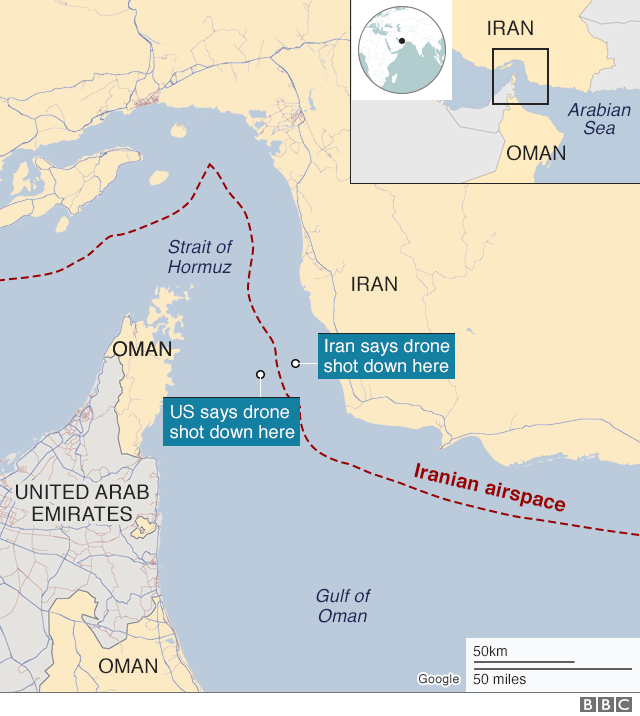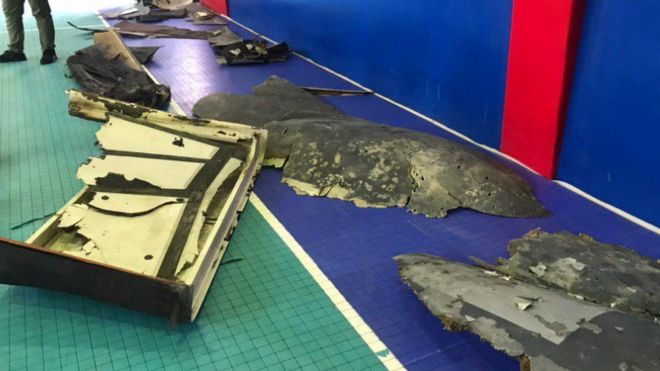The Military was 'Cocked and Loaded' to Retaliate But…-Trump


President
Donald Trump has said the US military was "cocked and loaded to
retaliate" against Iran, but he changed his mind 10 minutes before planned
strikes.
Attacks on
three sites were planned in response to the shooting down of a US unmanned
drone.
Mr Trump
said he had called off strikes after being told 150 people would die.
He tweeted:
"10 minutes before the strike I stopped it, not proportionate to shooting
down an unmanned drone".
The late
reversal was first reported by the New York Times on Thursday night. The
newspaper said the operation had been "in its early stages" when Mr
Trump stood the US military down.
"I am
in no hurry," Mr Trump said on Friday. "Our military is rebuilt, new,
and ready to go, by far the best in the world."
Tehran says
the unmanned US aircraft entered Iranian airspace early on Thursday morning.
The US maintains it was shot down in international airspace.
Tensions
have been escalating between the two countries, with the US recently blaming
Iran for attacks on oil tankers operating in the region. Iran has
announced it will soon exceed international agreed limits on its nuclear
programme.

Last year,
the US unilaterally pulled out of a 2015 nuclear deal aimed at curbing Iran's
nuclear activities.
"Iran
can NEVER have nuclear weapons," Mr Trump said in his tweets on the
aborted strikes - also revealing that increased economic sanctions against Iran
were "added last night".
In its initial
report, The New York Times said that as late as 19:00 local time (23:00 GMT) on
Thursday, US military and diplomatic officials had still expected the strikes
to take place on agreed targets, including Iranian radar and missile batteries.
"Planes
were in the air and ships were in position, but no missiles had been fired when
word came to stand down," the newspaper reported, citing an unnamed senior
administration official.
The strikes
had been set to take place just before dawn on Friday to minimise risk to the
Iranian military or to civilians, the newspaper added.
Tweeting on
Friday, Mr Trump said three sites had been targeted.
The
Associated Press quoted a US official as saying the strikes had been
recommended by the Pentagon and had been among options presented to senior
administration officials.
According to
the New York Times, top Pentagon officials warned a military response could
result in a spiralling escalation with risks for US forces in the region.
The
operation was called off after President Trump spent most of Thursday
discussing Iran with his national security advisers and congressional leaders,
AP reports.

US Secretary
of State Mike Pompeo and National Security Advisor John Bolton had pushed for a
hardline stance, but congressional leaders urged caution, the agency says.
Separately,
Reuters quoted two Iranian officials as saying Tehran had received a message
from Mr Trump through Oman overnight warning about an imminent US attack.
"Trump
said he was against any war with Iran and wanted to talk to Tehran about
various issues," one of the two officials said.
An Iranian
official warned that "any attack against Iran will have regional and
international consequences", while Russian President Vladimir Putin said a
war would be a "catastrophe with unpredictable consequences".
UN Secretary
General Antonio Guterres urged all parties to exercise maximum restraint.
In the US,
Democratic House Speaker Nancy Pelosi said the US had no appetite for war with
Iran, while the leading candidate for the Democratic presidential nomination,
Joe Biden, called Mr Trump's Iran strategy a "self-inflicted
disaster" Even the suggestion that President Trump ordered - and then
aborted - an attack on Iran, sends a powerful message to Tehran.
The two
countries came to the brink of direct conflict. But in this complex game of
signalling just what message will the Iranian leadership receive?
It, after
all, had sent a significant warning of its own by downing an unmanned US
reconnaissance drone.
Mr Trump
initially appeared to play down the incident - but then apparently came the
orders for a US retaliatory strike.
The danger
now is that Iran receives mixed messages that convey uncertainty and lack of
resolve. This might encourage some in Tehran to push back at the Americans even
harder.
There
appears to be no easy diplomatic "off-ramp" in this crisis.
US economic
sanctions are hitting home. Tehran is under pressure. Escalation remains an
ever-present danger.
Iran's
Islamic Revolutionary Guard Corps (IRGC) announced its air force had shot down
a US "spy" drone on Thursday morning after the unmanned aircraft
violated Iranian airspace near Kuhmobarak in the southern province of
Hormozgan.
IRGC
commander-in-chief Maj-Gen Hossein Salami said the drone's downing was a
"clear message" to the US that Iran's borders were "our red
line".
However, US
military officials maintain the drone was in international airspace over the
Strait of Hormuz at the time.
The US
Federal Aviation Administration (FAA) issued an emergency order on Thursday
evening prohibiting US airlines from operating in an overwater area of
Tehran-controlled airspace nearby in response.
Airlines
from other countries, including Britain's British Airways, the Dutch carrier
KLM, Emirates, and Qantas of Australia, have also said they will re-route their
flights to avoid parts of Iran.
The shooting
down of the drone followed accusations by the US that Iran had attacked two oil
tankers with mines last Thursday just outside the Strait of Hormuz, in the Gulf
of Oman.
FROM .bbc.com/news/world-us-canada

No comments